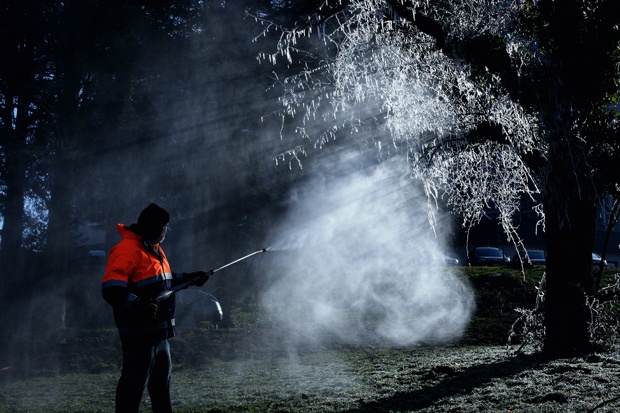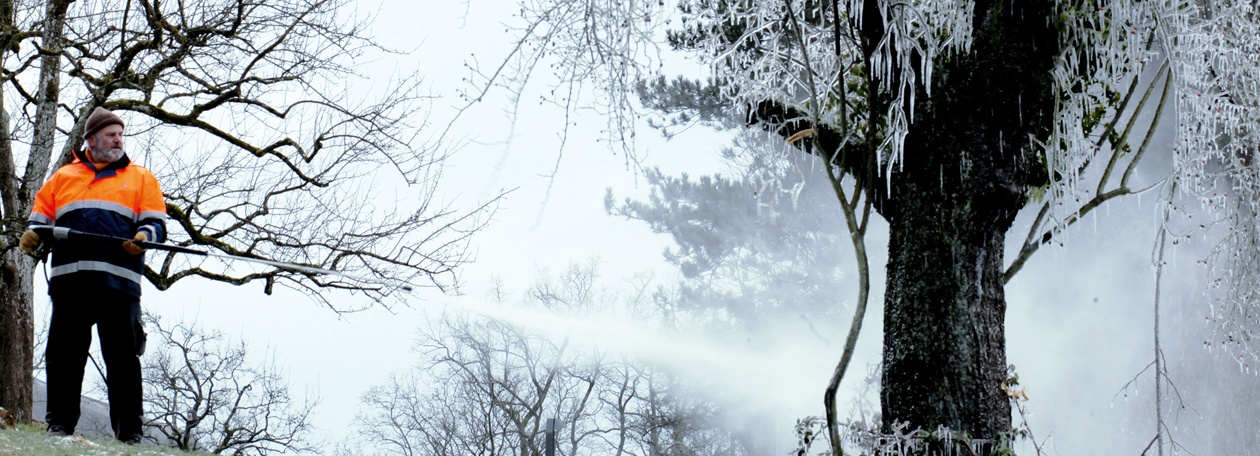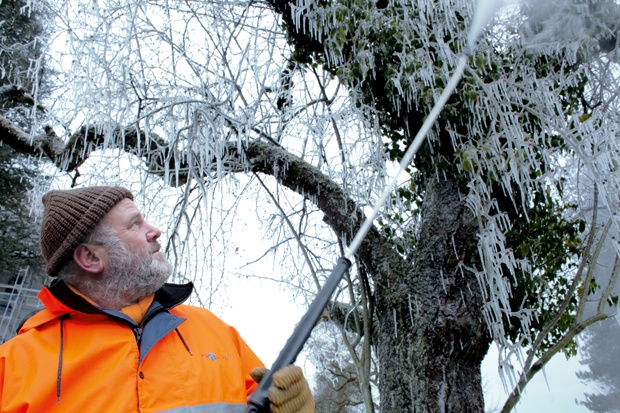Nature as an artist
Sparkling ice crystals, glittering mist clouds, white frost - nature is full of phenomena. As an artist Thomas Rappaport has a special eye for it. At the center of his project "giSCHt - melting sculptures" is the life of a cherry tree: After 80 years of blossoming, red fruit blossoms, shadow donations and as part of the climate, he makes him appear for the last time in extraordinary light.

Thomas Rappaport on his art project
Spray is a natural phenomenon that I would like to describe. The wind sweeps across the lake, absorbing water droplets to moisten trees and everything there. At corresponding seconds, it is possible to create bizarrely beautiful ice sculptures.
Water as "art-fabric"
I began as a wood sculptor, with quite traditional classical wooden sculptures standing on a pedestal. Over the years I discovered the tree itself as a material, then the standing, dead tree trunk, and finally the living tree. A few years ago I discovered by chance that my wooden sculptures have a completely different effect when they are placed in the water: the lift remains a part under the water surface and is still visible. The light breaks at the water level and thus the form of the sculpture. There was also a discovery: by photographing my floating wooden sculptures ("rafts") from below the water level, optical refractions and reflections were visible. So I began to perceive the water as an "art-substance".
All of this led to "looking at nature". She uses warmth and cold like a sculptor's chisel. There is a triple point , a point at which pressure conditions and temperature are such that the water - almost! - is simultaneously liquid , solid (even ice) and gaseous (steam / mist).
These experiences have been incorporated into the giSCHt project: I sprayed the dead cherry tree with a hot water high-pressure cleaner, in several steps, at temperatures below zero degrees, ie, permanent frost. There was an ice-litter above all else.

In harmony with nature
I had already met this tree in preparation for the different seasons, but during the intense work of day and night, with artificial light or during the day with sunshine, my experience became a dialogue.
How does the tree take the water? How does he deal with the cold? Parts of the ice thawed again, smaller branches broke under the weight. The challenge was to vary the water jet, to rhythmize it, to bring it into motion, to be in flowing forms, in the flow - and only at the moment. Part of this art concept is based on natural sciences. There were formerly, and even today, fruit-growers, who in March and April, when night-frosts threaten to destroy the flowers, so it is about the yields of the summer, put a mist over their blossoms. Thus, an icebreaker, which protects against frost, forms.
Paradox: The result is a kind of "heat pad" with a degree of minus minus, which then protects against the radiations, which can be ten degrees minus. Similar to an igloo that offers the Eskimos homely protection.

The aggregate conditions of the water
The pressure-temperature diagram
The pressure-temperature diagram shows the transitions into the different aggregate states. Depending on ambient pressure and temperature, all three aggregate states can be simultaneously present in one point, the so-called triple point.
When water begins to boil, which occurs at sea level at 100 degrees Celsius, liquid water evaporates to water vapor. Cooling water to zero degrees, freezes to solid ice. Conversely, ice melts at zero degrees to water. Water vapor again condenses to water at 100 degrees Celsius. If ice passes directly into the gaseous state, without passing through the liquid state of aggregation, it is called sublimation. It is a so-called drying out of ice. Conversely, steam evaporates to ice, visible as ice flowers or hoarfrost.
Mist occurs when water droplets are dispersed very finely in the air. This takes place when the air cools and can absorb less moisture. The excess water begins to condense.
Ripe forms when submerged water vapor passes directly from the gaseous state into the solid state. This occurs at temperatures below zero degrees Celsius.


Water is life - without water life would not be conceivable
Water is found in the earth in various shapes. The sun evaporates liquid water to water vapor. It becomes visible in the form of clouds or mist and returns as rain to the earth. At temperatures below zero degrees Celsius, water freezes to ice. Even today the glaciers are reminiscent of the last cold period, which lasted until about 10,000 years ago. Geothermal energy heats up water in the earth and causes hot water springs to develop. This water exits in gaseous form and rapidly condenses to the water vapor in the cooler air, a state of equilibrium between liquid and gaseous phase.
From our everyday life we know the three "state forms" of the water, also called aggregate states:
- fixed
- liquid
- gaseous
In the solid state, it is dimensionally stable, in the liquid state it conforms to the surrounding space, and in the gaseous state it completely fills the available space.
Thomas Hoffmann, mathematician, water economist, sculptor and pedagogue
About Thomas Rappaport
- Born in Zurich in 1957
- "Abitur" at a secondary school of fine arts
- Apprenticeship as a wood sculptor
- Work as a health care teacher
- Studied at the Freie Hochschule Stuttgart
- Teacher for arts and crafts
- Lecturer in adult education
- Since 1998 own studio in the Wildpark Stuttgart
- Since 1999 free art projects in the forest
- Since 2008 freelance artist
"His work combines human creativity and natural creation, artistic creation and divine creation. In his art he trusts himself in nature, takes it with his materials and his powers, guided by long experience and deep respect. He develops nature performances with great technical effort as powerful rituals. In them, he impressively impresses the beauties and powers of nature."
Dr. Tobias Wall, art historian

